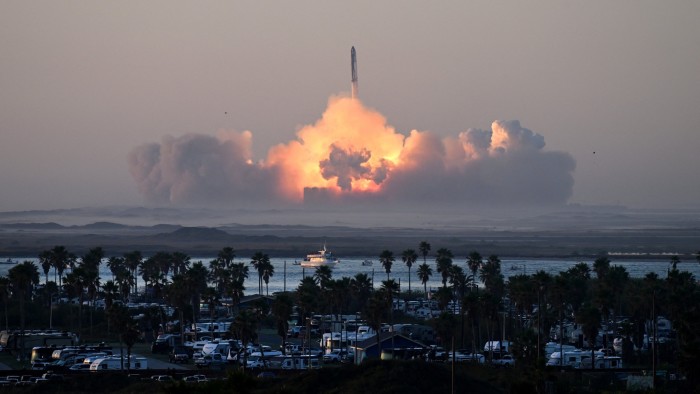Unlock the Editor’s Digest for free
Roula Khalaf, Editor of the FT, selects her favourite stories in this weekly newsletter.
Starbase, Texas, bills itself as the newest city in the Rio Grande valley. It’s also one of the smallest and most unusual. The tiny settlement, formerly known as Boca Chica, doesn’t have stoplights or public toilets. But it does have a rocket launch facility.
Sitting at the end of the southernmost highway in Texas, Starbase is a company town. The mayor here is also a senior employee at SpaceX, the Elon Musk space tech company that is dedicated to making humans into a multi-planetary species.
One of the first clues that Starbase isn’t like other cities is on the highway. Two murals have been painted on the roadside: one of Musk’s face accompanied by the words ad astra; the second of the doge meme — a goofy Shiba Inu dog that has been used to name both a cryptocurrency and Musk’s erstwhile “Department of Government Efficiency”.
On this particular Sunday in late summer the number of cars passing the murals was unusually high. Hundreds of people had travelled to Starbase to watch the tenth launch of Starship, a vast, reusable rocket that Musk hopes will one day take us to Mars.
Before its planned take off, Starship had to be moved from SpaceX HQ in town to the launch site a mile away, a process known as rollout. This gave the crowds their first close-up.
Alex, a software engineer visiting the US from Newfoundland for work, said he extended his trip to watch Starship take off. Others had come from the Netherlands, Sweden and the UK. The story of one man, who apparently travelled a day and a half from Australia, spread quickly through the group.
The Starship, mounted on a huge transport vehicle, rolled slowly towards us. At 52-metres tall it is about the height of a 15-storey building. As it turned on to the highway, people jumped into their cars to follow behind.
Many of those who travel to watch Musk’s rocket launches are fans of his other products too. Several Tesla Cybertrucks had gathered nearby in close formation, while a bright orange version sat on a small dune. Its owners had brought along chairs, appliances, and a tent housing a small chemical toilet. SpaceX caps and T-shirts were everywhere. One man was dressed in a full-length, silver replica of Starship. Another sported a T-shirt that read “HOPPY LOVES YOU” — a reference to the Starhopper, SpaceX’s first launch vehicle. Someone was using Musk’s Starlink terminal to livestream from the remote site.
As the day wore on, attention turned to “stacking”, the process of mounting Starship on to the Super Heavy booster rocket. Almost everyone I spoke to had a favourite launch: launch five — the first in which the rocket’s booster returned and was caught by enormous metal “chopsticks” on the rocket’s launch tower.
But amid the excitement there was a note of anxiety. The previous three Starship flight tests ended in what SpaceX calls rapid unscheduled disassembly — in other words, disintegration.
As the rocket’s 6.30pm launch window approached, I settled in to watch at the Rocket Ranch outpost, a small property at the very edge of the exclusion zone, about four miles from the launch pad. I was told that if Starship exploded, I’d have 16 seconds to hit the ground and cover my ears.
Then a voice came over a nearby speaker with bad news. The launch was off, at least for now, due to an unspecified “issue with ground systems”.
On day two, the crowd was noticeably smaller. A menacing cloud overhead forced the second attempt to be aborted.
By day three, the mood was muted and the crowd even thinner. The food truck selling BBQ and beers at the outpost had closed.
This time, however, conditions were far better. The stacked rocket took off and glided serenely upward. The crowd whooped and cheered. One man stood on his truck, pumping his fist. Within minutes, Starship was 190km above the Earth. An hour later it splashed down in the Indian Ocean. By then, the rocket watchers in Starbase had said their goodbyes. They’d see each other next time.

